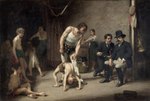Top Qs
Timeline
Chat
Perspective
Nils Forsberg
Swedish painter (1842–1934) From Wikipedia, the free encyclopedia
Remove ads
Nils Forsberg (17 December 1842 – 8 November 1934) was a Swedish painter who lived and worked in Paris for much of his career.[2]
Life
Summarize
Perspective
Forsberg was born to a destitute family in a small village called Riseberga, in the province of Scania.[3][1] The son of a peasant, he spent his early years in farming, then was apprenticed to a house-painter in Gothenburg.[3] He made a statue of Minerva which procured for him a government stipend which enabled him to go to Paris in 1867.[3] In Paris he was a student in the atelier of Léon Bonnat.[4][3][5] Art historian Richard Muther would later write that Forsberg "became the Swedish Bonnat".[6] The siege of Paris, during which he enlisted in the Ambulance Department, afforded him opportunities for studying and sketching the scenes that he observed.[3] In 1877 he exhibited Family of Acrobats before the Circus Director, now in the Gothenburg Museum of Art.[3] This work, which typifies Forsberg's commitment to social reform, shows the influence of the French Realists in its depiction of child labor.[2]


In 1888 he received the gold medal at the Salon for his painting The Death of a Hero,[5][6][7] now in the Nationalmuseum of Stockholm.[8] The culmination of his ambition to renew traditional history painting with a vigorous contemporary realism, it took him several years to complete, and was inspired by his experiences during the Franco-Prussian War.[2] Afterwards he devoted himself more especially to historical subjects.[3] In 1904 he returned to Sweden, where he lived in Helsingborg.[2] He died in Helsingborg on 8 November 1934.[1][2]
He had a son, Nils Forsberg the younger (b 1870), who was also a painter.[2]
Remove ads
Permanent collections
In total, 25 of Forsberg's works are held by the Nationalmuseum.[8] Several of his works, including the 1900 painting Gustaf II Adolf before Battle of Lützen,[9] are held by the Gothenburg Museum of Art.[10]
Gallery
- A Communard (1871) Nationalmuseum
- Family of Acrobats before the Circus Director (1877)
- Gustav II Adolf before the Battle of Lutzen of 1632, in which the king died. Gothenburg Museum of Art, 1900
- Stenbock's Courier (1911)
- Self-portrait (1882)
References
Further reading
Wikiwand - on
Seamless Wikipedia browsing. On steroids.
Remove ads






